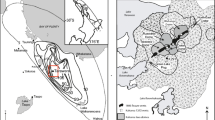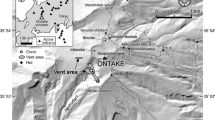Abstract
The caldera of Pululagua is an eruptive centre of the Northern Volcanic Zone of the South American volcanic arc, located about 15 km north of Quito, Ecuador. Activity leading to formation of the caldera occurred about 2450 b.p. as a series of volcanic episodes during which an estimated 5–6 km3 (DRE) of hornblende-bearing dacitic magma was erupted. A basal pumice-fall deposit covers more than 2.2x104 km2 with a volume of about 1.1 km3 and represents the principal and best-preserved plinian layer. Circular patterns of isopachs and pumice, lithic and Md isopleths of the Basal Fallout (BF) around the caldera indicate emplacement in wind-free conditions. Absence of wind is confirmed by an ubiquitous, normally graded, thin ash bed at the top of the lapilli layer which originated from slow settling of fines after cessation of the plinian column (co-plinian ash). The unusual atmospheric conditions during deposition make the BF deposit particularly suitable for the application and evaluation of pyroclast dispersal models. Application of the Carey and Sparks' (1986) model shows that whereas the 3.2-, 1.6-, and 0.8-cm lithic isopleths predict a model column height of about 36 km, the 6.4-cm isopleth yields and estimate of only 21 km. The 4.9- and 6.4-cm isopleths yield a column height of 28 km using the model of Wilson and Walker (1987). The two models give the same mass discharge rate of 2x108 kg s-1. A simple exponential decrease of thickness with distance, as proposed by Pyle (1989) for plinian falls, fits well with the BF. Exponential decrease of size with distance is followed by clasts less than about 3 cm, suggesting, in agreement with Wilson and Walker (1987), that only a small proportion of large clasts reach the top of the column. Variations with distance in clast distribution patterns imply that, in order to obtain column heights by clast dispersal models, the distribution should be known from both proximal and distal zones. Knowledge of only a few isopleths, irrespective of their distance from the vent, is not sufficient as seemed justified by the method of Pyle (1989).
Similar content being viewed by others
References
Barberi F, Cioni R, Rosi M, Santacroce R, Sbrana A, Vecci R (1989) Magmatic and phreatomagmatic phases in explosive eruptions of Vesuvius as deduced by grain-size and component analysis of the pyroclastic deposit. J Volcanol Geotherm Res 38:287–307
Barberi F, Coltelli M, Ferrara G, Innocenti F, Navarro JM, Santacroce R (1988) Plio-Quaternary volcanism in Ecuador. Geol Mag 125:1–14
Carey S, Sigurdsson H (1980) The Roseau Ash: deep-sea tephra deposits from a major eruption on Dominica, Lesser Antilles arc. J Volcanol Geotherm Res 7:67–86
Carey S, Sigurdsson H (1987) Temporal variations of column height and magma discharge rate during the 79 AD eruption of Vesuvius.Geol Soc Am Bull 99:303–314
Carey S, Sigurdsson H (1989) The intensity of plinian eruptions. Bull Volcanol 51:28–40
Carey S, Sparks RSJ (1986) Quantitative models of the fallout and dispersal of tephra from volcanic eruption columns. Bull Volcanol 48:109–125
Carey S, Sigurdsson H, Sparks RSJ (1988) Experimental studies of particle laden plumes. J Geophys Res 93 B12:15314–15328
Crandell DR, Mullineaux DR (1973) Pine Creek volcanic assemblage at Mount St. Helens, Washington. US Geol Surv Bull 1383-A:1–23
Fisher RV, Glicken HX, Hoblitt RP (1987) May 18, 1980, Mount St Helens deposits in South Coldwater Creek, Washington. J Geophys Res 92, B10:10267–10283
Froggatt PC (1982) Review of methods of estimating rhyolitic tephra volumes; applications to the Taupo Volcanic Zone, New Zealand. J Volcanol Geotherm Res 14:301–318
Geotermica Italiana-INEMIN (1989) Mitigacion del Riesgo Volcanico en el Area Metropolitana de Quito. Ministero degli Affari Esteri-DGCS. Pisa
Hall ML (1977) El volcanismo en el Ecuador. IPGM Seccion Nacional del Ecuador, Quito
Houghton BF, Wilson CJN (1989) A vesicularity index for pyroclastic deposits. Bull Volcanol 51:451–462
Howorth R (1975) New formations of Late Pleistocene tephras from the Okataina Volcanic Centre, New Zealand. N Z J Geol Geophys 18 (5):683–712
Isaacson JS (1987) Volcanic activity and human occupation of the Northern Andes: the application of tephrostratigraphic techniques to the problem of human settlement in the Western Montaña during the Ecuadorian Formative. PhD thesis, University of Illinois
Morton BR, Taylor G, Turner JS (1956) Turbulent gravitational convection from maintained and instantaneous sources. Phil Trans R Soc London Ser A 234:1–23
Pyle DM (1989) The thickness, volume and grainsize of tephra fall deposits. Bull Volcanol 51:1–15
Rose WI, Bonis S, Stoiber RE, Keller M, Bickford T (1973) Studies of volcanic ash from two recent Central America eruptions. Bull Volcanol 37:338–364
Rosi M (1992) A model for the formation of vesiculated tuff by coalescence of accretionary lapilli. Bull Volcanol 54:429–434
Self S, Sparks RSJ (1978) Characteristics of widespread pyroclastic deposits formed by the interaction of silicic magma and water. Bull Volcanol 41:196–212
Settle M (1978) Volcanic eruption clouds and the thermal output of explosive eruptions. J Volcanol Geotherm Res 3:309–324
Simkin T, Siebert L, McClell L, Bridge D, Newhall C, Latter JH (1981) Volcanoes of the world. Stroudsburg, Pennsylvania: Hutchinson Ross 232 pp
Sparks RSJ (1986) The dimensions and dynamics of volcanic eruption columns. Bull Volcanol 48:3–15
Suzuki T, Katsui Y, Nakamura T (1973) Size distribution of the Tarumai Ta-b pumice-fall deposit. Bull Volcanol Soc Japan 18:47–64
Villalba M (1988) Cotocollao: una aldea formativa del valle de Quito. Museo del Banco Central del Ecuadon, Quito
Vucetich CG, Pullar WA (1973) Holocene tephra formations erupted in the Taupo area, and interbedded tephras from other volcanic sources. N Z J Geol Geophys 16:745–780
Walker GPL (1971) Grainsize characteristics of pyroclastic deposits. J Geol 79:696–714
Walker GPL (1980) The Taupo pumice: product of the most powerful known (ultraplinian) eruption? J Volcanol Geotherm Res 8:69–94
Walker GPL (1981) Plinian eruptions and their products. Bull Volcanol 44-2:223–240
Walker GPL (1983) Ignimbrite types and ignimbrite problems. J Volcanol Geotherm Res 17:65–88
Walker GPL, Croasdale R (1971) Two Plinian-type eruptions in the Azores. J Geol Soc London 127:17–56
Williams H (1960) Volcanic history of the Guatemalan Highlands. Univ Calif Publ Geol Sci 38:1–87
Wilson L (1972) Explosive volcanic eruptions—II. The atmospheric trajectories of pyroclasts. Geophys J R astr Soc 30:381–392
Wilson L (1976) Explosive volcanic eruptions—III. Plinian eruption columns. Geophys J R astr Soc 45:543–556
Wilson L (1980) Relationships between pressure, volatile content and ejecta velocity in three types of volcanic explosions. J Volcanol Geotherm Res 8:297–313
Wilson L, Huang TC (1979) The influence of shape on the atmospheric settling velocity of volcanic ash particles. Earth Planet Sci Lett 44:311–324
Wilson L, Walker GPL (1987) Explosive volcanic eruptions—VI. Ejecta dispersal in plinian eruptions: the control of eruption conditions and atmospheric properties. Geophys J R astr Soc 89:657–679
Wilson L, Sparks RSJ, Huang TC, Watkins ND (1978) The control of volcanic column height by eruption energetics and dynamics. J Geophys Res 83:1829–1835
Woods AW (1988) The fluid dynamics and thermodynamics of eruption columns. Bull Volcanol 50:169–193
Author information
Authors and Affiliations
Rights and permissions
About this article
Cite this article
Papale, P., Rosi, M. A case of no-wind plinian fallout at Pululagua caldera (Ecuador): implications for models of clast dispersal. Bull Volcanol 55, 523–535 (1993). https://doi.org/10.1007/BF00304594
Received:
Accepted:
Issue Date:
DOI: https://doi.org/10.1007/BF00304594




